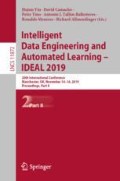Abstract
Many modern applications use services and data made available by provisioning platforms of third parties. The question arises if the use of individual services and data resources such as open data by novel applications can be predicted. In particular, whether initial software development efforts such as application development during hackathons can be monitored to provide data for the models predicting requests submitted to open data platforms and possibly other platforms is not clear.
In this work, we propose an iterative method of transforming request streams into activity records. By activity records, vectors containing aggregated representation of the requests for external services made by individual applications over growing periods of software development are meant. The approach we propose extends previous works on the development of network flows aggregating network traffic and makes it possible to predict future requests made to web services with high accuracy.
Access this chapter
Tax calculation will be finalised at checkout
Purchases are for personal use only
References
Bostani, H., Sheikhan, M.: Hybrid of anomaly-based and specification-based IDS for Internet of Things using unsupervised OPF based on MapReduce approach. Comput. Commun. 98, 52–71 (2017)
Grabowski, S., Grzenda, M., Legierski, J.: The adoption of open data and open API telecommunication functions by software developers. In: Abramowicz, W. (ed.) BIS 2015. LNBIP, vol. 208, pp. 337–347. Springer, Cham (2015). https://doi.org/10.1007/978-3-319-19027-3_27
Hofstede, R.: Flow monitoring explained: From packet capture to data analysis with NetFlow and IPFIX. IEEE Commun. Surv. Tutor. 16(4), 2037–2064 (2014)
Kim, H., Claffy, K., Fomenkov, M., Barman, D., Faloutsos, M., Lee, K.: Internet traffic classification demystified: myths, caveats, and the best practices. In: Proceedings of the 2008 ACM CoNEXT Conference, CoNEXT 2008, pp. 11:1–11:12. ACM, New York (2008). https://doi.org/10.1145/1544012.1544023
Otoum, S., Kantarci, B., Mouftah, H.: Adaptively supervised and intrusion-aware data aggregation for wireless sensor clusters in critical infrastructures. In: 2018 IEEE International Conference on Communications (ICC), pp. 1–6, May 2018
Pektaş, A., Acarman, T.: Deep learning to detect botnet via network flow summaries. Neural Comput. Appl. (2018). https://doi.org/10.1007/s00521-018-3595-x
Sperotto, A., Schaffrath, G., Sadre, R., Morariu, C., Pras, A., Stiller, B.: An overview of IP flow-based intrusion detection. IEEE Commun. Surv. Tutor. 12(3), 343–356 (2010). https://doi.org/10.1109/SURV.2010.032210.00054
Thorsby, J., Stowers, G.N., Wolslegel, K., Tumbuan, E.: Understanding the content and features of open data portals in American cities. Gov. Inf. Q. 34(1), 53–61 (2017)
Acknowledgment
This research has been partly supported by the European Union’s Horizon 2020 research and innovation programme under grant agreement No. 688380 VaVeL: Variety, Veracity, VaLue: Handling the Multiplicity of Urban Sensors.
Author information
Authors and Affiliations
Corresponding author
Editor information
Editors and Affiliations
Rights and permissions
Copyright information
© 2019 Springer Nature Switzerland AG
About this paper
Cite this paper
Grzenda, M., Kunicki, R., Legierski, J. (2019). The Use of Unified Activity Records to Predict Requests Made by Applications for External Services. In: Yin, H., Camacho, D., Tino, P., Tallón-Ballesteros, A., Menezes, R., Allmendinger, R. (eds) Intelligent Data Engineering and Automated Learning – IDEAL 2019. IDEAL 2019. Lecture Notes in Computer Science(), vol 11872. Springer, Cham. https://doi.org/10.1007/978-3-030-33617-2_7
Download citation
DOI: https://doi.org/10.1007/978-3-030-33617-2_7
Published:
Publisher Name: Springer, Cham
Print ISBN: 978-3-030-33616-5
Online ISBN: 978-3-030-33617-2
eBook Packages: Computer ScienceComputer Science (R0)

